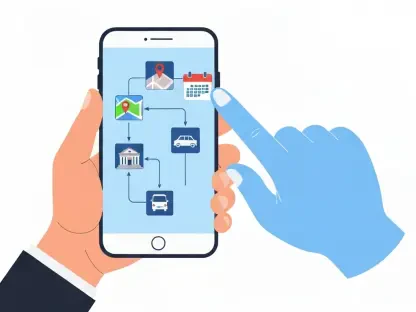What happens when a tech titan repeatedly invents the future but struggles to own it? Picture a company that unveils groundbreaking tools—think augmented reality headsets or AI chatbots—only to see rivals refine and dominate those very ideas. Microsoft stands at this crossroads once again with its generative AI push, sparking curiosity about whether it can finally turn vision into victory. This exploration dives into the challenges and stakes of transforming prototypes into market-defining successes, focusing on the tech giant’s latest endeavors and historical patterns.
Why This Moment Is Critical for Microsoft
The AI revolution is reshaping industries at a breakneck pace, placing immense pressure on Microsoft to capitalize on its early leads. Tools like Copilot and Bing Chat have positioned the company as a frontrunner in generative AI, yet the risk of faltering looms large. Failing to sustain momentum now could mean ceding ground to competitors like Google, impacting everything from workplace productivity to consumer tech experiences. This isn’t just a corporate battle; it’s about shaping the digital tools that define daily life.
Beyond the immediate stakes, Microsoft’s journey resonates with anyone invested in technology’s trajectory. The outcome of its AI efforts could influence how accessible and innovative future solutions become for millions. With the global AI market projected to grow by 37% annually through 2030, according to industry reports, the race for dominance is more urgent than ever. Microsoft’s ability to navigate this landscape holds implications far beyond its own balance sheet.
Unpacking the Prototype-to-Market Barrier
Microsoft’s history reveals a recurring hurdle: pioneering ideas that generate buzz but struggle to maintain traction. Take HoloLens, launched a decade ago as a visionary augmented reality device with demos like Minecraft integration. Initial excitement faded as focus shifted to enterprise applications, culminating in a failed military contract worth billions before the project pivoted to another firm in recent years. This pattern of early promise followed by strategic retreat highlights a core challenge in sustaining market relevance.
Another telling case lies in the smartphone arena with Windows Phone. Despite early recognition of mobile computing’s potential, Microsoft couldn’t match the rapid evolution of Apple’s iOS or Google’s Android. A delayed response to touchscreen trends and consumer preferences left the platform obsolete, showing how missteps in timing and adaptation can derail even the most innovative starts. Each example underscores a difficulty in aligning cutting-edge concepts with evolving user demands.
Then there’s Internet Explorer, once a dominant force in web browsing. Its stagnation—particularly with version 6, which lingered without major updates for years—allowed competitors like Firefox and Chrome to surge ahead. Microsoft’s slow iteration and focus on proprietary systems over user needs opened the door for others to redefine the space. These lessons remain relevant as the company navigates the AI frontier, where agility and consumer focus are non-negotiable.
Expert Perspectives on Past and Present Challenges
Insights from industry observers shed light on Microsoft’s recurring struggles with execution. Tech historian Mark Wilson points out, “Microsoft often sparks revolutions with its prototypes, but follow-through has historically been inconsistent—Internet Explorer’s complacency is a prime example of losing a winnable war.” This observation rings true when examining how rivals have built on Microsoft’s early ideas to capture markets.
In the realm of AI, recent critiques highlight similar concerns. AI researcher Lena Carter notes, “When Bing Chat gained traction for personal conversations, Microsoft’s quick restrictions showed a lack of foresight in user behavior. It’s a reactive stance, not a strategic one.” Such feedback suggests that anticipating and adapting to how people engage with technology remains a critical gap. Even with substantial investments, like the early partnership with OpenAI, the path to leadership isn’t guaranteed without proactive adjustments.
Current leadership under Satya Nadella offers a glimmer of change, with ambitious goals for Copilot to serve as a “life companion” for users. Yet skepticism persists, especially given past financial hits, such as the massive write-downs tied to HoloLens contracts. These voices collectively paint a picture of a company with immense potential, but one that must overcome ingrained tendencies to pivot away from consumer markets at pivotal moments.
Strategies to Break the Cycle of Missed Opportunities
Addressing historical pitfalls requires deliberate action if Microsoft aims to dominate with AI. One key approach involves maintaining a relentless focus on consumer needs. Unlike the shift seen with HoloLens toward niche enterprise uses, tools like Copilot must prioritize accessibility and regular updates driven by real user feedback. This ensures relevance in a crowded, fast-moving market where end-user experience often dictates success.
Speed in iteration also stands out as a vital tactic. Drawing from the stagnation of Internet Explorer, Microsoft should commit to frequent enhancements for its AI offerings. Rolling out new features for Copilot on a consistent basis could prevent competitors from closing the gap, keeping the tool at the forefront of innovation. Agility in development cycles isn’t just an option; it’s a necessity in today’s tech landscape.
Finally, anticipating user behavior through robust testing could prevent missteps like those seen with Bing Chat’s restrictive limits. Deploying beta programs to understand engagement patterns before full-scale launches offers a way to adapt proactively. Balancing this with a dual focus on enterprise and consumer applications—leveraging strengths like Azure while not neglecting everyday users—could create a comprehensive strategy to transform early AI wins into enduring market leadership.
Reflecting on a Legacy of Near Misses
Looking back, Microsoft’s journey through innovation has often been a tale of brilliant beginnings overshadowed by strategic stumbles. From the ambitious unveilings of HoloLens to the early promise of Windows Phone, the company has repeatedly demonstrated foresight, only to lose momentum when it mattered most. Even in the browser wars, initial dominance with Internet Explorer slipped through its fingers as others adapted faster.
The AI chapter, though still unfolding, has shown both potential and familiar risks. Bing Chat’s viral start was tempered by self-imposed constraints, echoing past misjudgments of market needs. Yet, under determined leadership, there is a chance to rewrite this narrative. The push with Copilot offers a fresh canvas to apply hard-learned lessons.
Moving forward, the path to dominance hinges on sustained commitment—keeping consumer needs central, iterating swiftly, and predicting user trends with precision. If Microsoft can integrate these strategies, it might not just pioneer but also preserve its place at the top. The tech world watches closely, ready to see if this giant can finally turn its visionary sparks into a lasting blaze.









